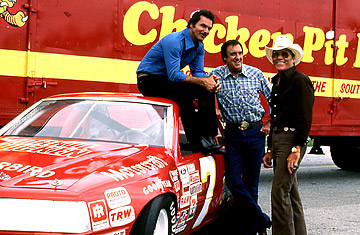
Burt Reynolds poses with Jim Nabors and Hal Needham during the 1982 filming of Stroker Ace at the Lakewood Park Speedway in Atlanta
After jumping, falling, crashing and burning on the set of more than 300 films, Hal Needham became the first Hollywood stuntman to transition to film directing with his 1977 feature Smokey and the Bandit. In that movie, he became the first director to include outtakes in the end credits, now a standard in action, comedy and animated films. In his new memoir, Stuntman! My Car-Crashing, Plane-Jumping, Bone-Breaking, Death-Defying Hollywood Life, Needham recalls career highlights such as doubling for stars like Burt Reynolds and Dean Martin and teaching John Wayne how to really throw a punch. He spoke to TIME about the mental and physical preparations involved in putting together a stunt, his distaste of CGI and why he has never once turned down a stunt.
You've broken 56 bones and your back twice. Was there ever a point where you thought enough was enough?
When you're hungry, you don't think about things like that. It never crossed my mind. I don't know if I thought I was invincible or what. But I just lay in the hospital bed waiting for the day I could go back to work.
What was the scariest stunt you ever worked on?
In Little Big Man, Alan Gibbs and myself had to jump from one horse to the next one at full gallop. If you fell off, you'd have two, four, six horses — depending on where you were — and a 45-lb. stagecoach run over your mean ass. So that was physically demanding and a little on the scary side.
You write about how the physical training of horses and stuntmen could take up to four months. How did you mentally prepare yourself to risk life and limb for each trick?
Anyone who thinks stuntmen are crazy is dead wrong. These guys are calculating. They rig things, they think about different ways of doing it ... they're not afraid. I probably did a million dollars worth of stunt practicing, so anytime I went into a stunt, I thought I was ready. Both mentally and physically. Of course I was wrong a lot of times. But confidence will override fear. I didn't think about, "What if I do this wrong? Am I gonna get hurt?" That never crossed my mind.
So you never thought any of your stunts would go badly?
Absolutely not. Otherwise I wouldn't have done it. I'd change the stunt or maybe do something to make it a less spectacular but also a little less dangerous. But audiences pay for the [spectacle] and the danger, so I'd prepare myself for the biggest payoff.
Were there any stunts you refused to do?
Never. I never turned down a stunt in my life.
Has it ever bothered you to risk your life to perform stunts and then have the actor get all the credit?
I was doing stunts for money, not for fame. So it never bothered me. But when I first came into the business, the stunt guys got a little upset for that [very] reason. But you don't want people to see a movie and sit there trying to figure out whether it's a stuntman or whether it's an actor doing the stunt. So why bring it to their attention? Let them just enjoy the movie and not worry about this stuff.
Computer-generated imagery has dramatically changed the size and scale of stunts in filmmaking. What's your take on its use?I'm not a big fan of CGI. When I look at it, I go: "Wait a minute. That's not possible." And I think other people see the same thing. The movies I worked on, we did stunts for real. And I think it shows.
You became good friends with many famous actors during your career, including Burt Reynolds and John Wayne. What were they like to work with?
I don't think I've had a better friend than Burt Reynolds. I could ask him for almost anything, and he would have said O.K. To be a No. 1 box-office movie star and take a stuntman and let him direct his next movie? That's putting it all on the line. That's what you call a friend. Duke was a guy who was always prepared and dedicated. He knew every job on the set and could do most of them. As long as you did your job, he was good to you. But boy, you better not start goofing around. Because if you did, he'd be on you like ugly on an ape.
You even taught him how to throw a punch the right way.
John Wayne had done a gazillion movie fights, but sometimes he'd just get a little confused. A camera has no depth perception so if the camera is behind you when you pull the punch, you have to throw it across the other guy's face. If the camera is on your side, you have to throw it by the guy's ear. The director on [The Undefeated] didn't want me to go up there and correct him, but finally after four or five times, I just said to his face, "Hey Duke, here's what you need to do." I threw the correct punch and the camera operator said, "That works." That night, Duke grabbed me and gave me a gut rub, but that was all done in jest. That was his way of saying thanks.
